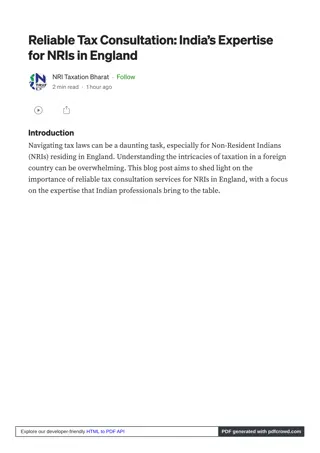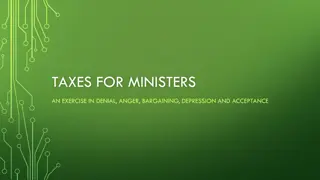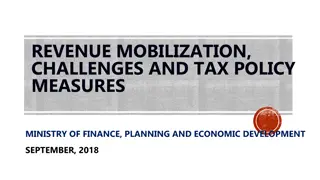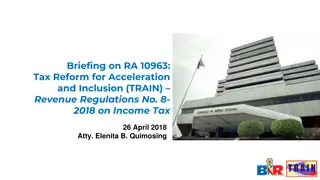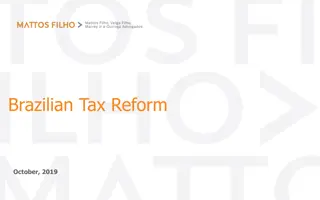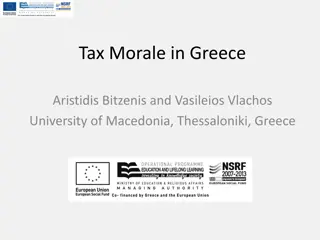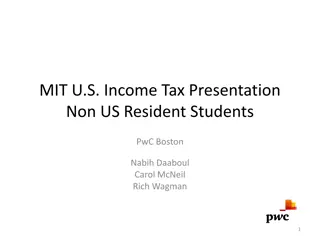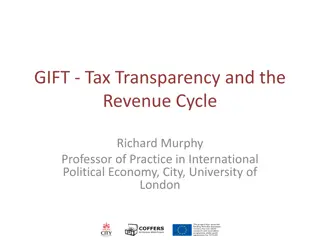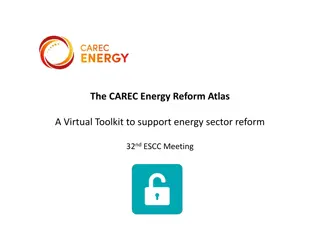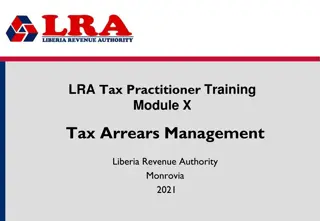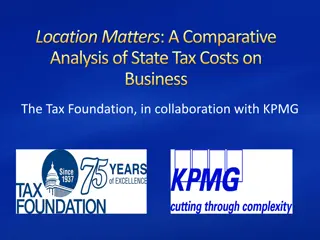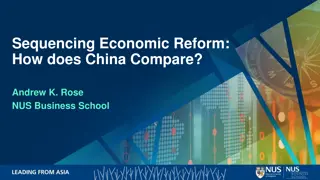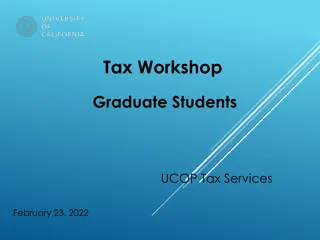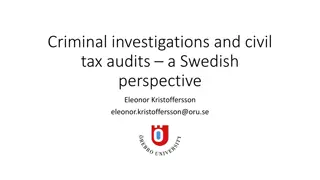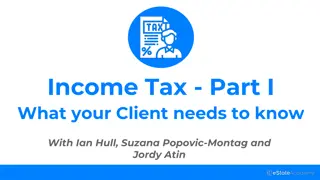The Case for Tax Reform: Challenges and Solutions
Exploring the need for tax reform and the obstacles hindering its implementation, this article delves into the complexities of effective personal income tax rates, changing tax brackets, and the factors contributing to lower effective rates compared to statutory rates. It also highlights the loopholes and shortcomings in the current tax system, emphasizing the importance of addressing these issues for a more equitable and efficient tax structure.
Download Presentation

Please find below an Image/Link to download the presentation.
The content on the website is provided AS IS for your information and personal use only. It may not be sold, licensed, or shared on other websites without obtaining consent from the author. Download presentation by click this link. If you encounter any issues during the download, it is possible that the publisher has removed the file from their server.
E N D
Presentation Transcript
Why We Need Tax Reform and Why We Probably Won t Get It Robert Coen Professor Emeritus of Economics Northwestern University Woman s Athletic Club Chicago, IL January 23, 2013
Effective Personal Income Tax Rate, 1947-2011 Ratio of Personal Income Tax Revene to Personal Income (%) 14 Average (red line) = 9.7 12 10 Percent 8 6 4 2 0 50 55 60 65 70 75 80 85 90 95 00 05 10 Year Source data: Commerce Department, National Income Accounts
The Changing Personal Income Tax Single Taxpayer 1stbracket Top bracket --------------------------- Rate Number of ------------------------- Brackets Rate Year Income< Income> 1955 24 20% $16,745 91% $1,674,475 1988 2 15% 33,856 28% 33,856 2007 6 10% 8,468 35% 378,435 Income levels are adjusted for inflation and stated in 2011 dollars. In each of these years, tax revenue = 9.7% of personal income Source: The Tax Foundation
Effective Personal Income Tax Rates by Household Income, 2007 Average pre-tax income Share of pre-tax income Income quintile Effective tax rate Share of taxes Lowest -6.8 18,400 4 -3 Second -0.4 42,500 8 0 Third 3.3 64,500 13 5 Fourth 6.2 94,100 19 13 Highest 14.4 264,700 56 86 All 9.3 96,000 100 100 Top 1% 19.0 1,873,000 19 40 Source: Congressional Budget Office
Why Are Effective Rates Much Lower Than Statutory Rates? Some types of income not subject to tax: Employer-provided health insurance Contributions to retirement programs Interest on state-local bonds Basic income level exempted from tax: Personal exemptions Standard deduction Some uses of income deductible: Charitable contributions Medical expenses State-local income, property taxes Tax credits for some uses of income: Energy-efficient windows, appliances, heating Earned income tax credit (1975) Child tax credit (1998) Refundable tax credits = negative tax : Some types of income taxed lightly: Capital gains
Shortcomings of Tax Loopholes Hidden form of spending tax expenditures Alternative is direct expenditure (subsidy),regularly reassessed Open-ended cost Difficult to get rid of, may outlive usefulness Incentive effects vary (undesirably?) across taxpayers Invite creative behavior to avoid taxes Convert ordinary income to capital gain Substitute home equity loan for other consumer borrowing Abuse and verification issues Erosion of tax base requires higher, distorting tax rates Waste of (limited!) human talent in legal and accounting professions
Direct Spending and Tax Expenditures by Category, 2011 Billions of dollars Direct Tax National Defense and Veterans Benefits International Affairs General Science, Space, and Technology Energy, Natural Resources and Environment 832.8 45.7 29.5 57.7 13.1 36.3 10.3 13.3 Agriculture, Commerce and Housing Transportation Community and Regional Development Education, Training, Employment, Social Services 8.1 93.0 23.8 101.2 418.3 6.0 4.3 167.7 Health and Medicare Income Security Social Security General Government 858.2 597.4 730.8 25.5 202.6 198.4 31.0 72.8 Total outlays 3,603.1 1,175.5 Sources: Office of Management and Budget, Joint Committee on Taxation
Strengths of Tax Loopholes Allow private preferences to allocate subsidies
Effective and Statutory Corporate Income Tax Rate, 1948-2011 Ratio of Corporate Income Tax Revenue to Corporate Profits (%) 70 60 50 Percent 40 30 20 10 50 55 60 65 70 75 80 85 90 95 00 05 10 Year Effective rate Staturtory rate Source data: Commerce Department, National Income Accounts
Income Tax Reform of 1986 Goals Reduce tax rates to improve economic efficiency and growth Maintain tax revenue by eliminating some tax expenditures Personal Tax Reduced number of brackets from 15 to 2 Reduced top rate from 50 to 28 percent Eliminated deduction for interest paid, except on home mortgages Eliminated deduction for state-local sales taxes Eliminated favored rates for long-term capital gains Corporate Tax Reduced top rate from 46 to 34 percent Repealed tax credit for equipment investment Tightened depreciation rules
Undoing of 1986 Reforms 1991 Top personal rate raised from 28% to 31%, Brackets increased from 2 to 3 Top rate personal rate raised to 39.6% Brackets increased from 3 to 5 Top corporate rate raised to 35% Capital gains rate reduced to 28% Refundable child tax credit of $500 Capital gains rate reduced to 20% Personal rate to fall gradually from 39.6% to 35% Brackets to increased from 5 to 6 Child credit raised to $1K Estate tax reduced, to be eliminated in 2010 Accelerated reductions in top rates Dividends and KG rates reduced to 15% 1993 1997 2001 2003 Numerous grants of accelerated depreciation Numerous new tax credits biofuels, etc.
Alternative Proposals for Tax (Re)Reform Romney: Personal tax cuts 1st bracket from 10% to 8% Top bracket from 35% to 28% Eliminate taxes on capital income Reduce corporate rate from 35% to 25% Pay for by eliminating unspecified tax expenditures TPC estimated 2015 cost at $480b
Estimated Cost of 10 Largest Personal Tax Expenditures Billions of dollars Annual average 2010-14 Exclusion of employer contributions for health care Deduction of mortgage interest Reduced tax rates on capital gains and dividends Exclusion of pension contributions defined benefit plans Earned income credit 131.9 96.8 80.6 60.6 53.8 Deduction of state-local taxes Exclusion of pension contributions defined contribution plans Exclusion of capital gains at death Deduction of charitable contributions Exclusion of untaxed social security and railroad retirement 47.5 42.4 38.4 36.5 34.6 Total of largest 10 623.1 Source: U.S. Congress, Joint Committee on Taxation
Estimated Cost of 10 Largest Corporate Tax Expenditures Billions of dollars Annual average 2010-14 Deferral of income of controlled foreign corporations Exclusion of interest on state-local debt Deduction of income from domestic production activities Inventory property sales source rule exception Accelerated depreciation of equipment 14.1 9.1 8.6 7.6 7.4 Inclusion of income from business debt discharged by reacquisition Tax credit for low-income housing Expensing of R&D expenditures LIFO inventory accounting Reduced tax rate for first $10mil of taxable income 5.8 5.4 5.1 4.0 3.2 Total of largest 10 70.3 Source: U.S. Congress, Joint Committee on Taxation
Alternative Proposals for Tax (Re)Reform Obama s Deficit Commission (Simpson-Bowles, Dec. 2010): Reduce personal rates to 12%, 22%, 28% Cut corporate tax cut to 28% Pay for by: Taxing dividends and capital gains like other income Eliminating personal and corporate tax expenditures, except: Child and earned income credits Mortgage interest (within limits) Employer-provided health insurance (with cap) Charitable giving (>2% of income, 12% refundable credit Exclusion of state-local bond interest Retirement savings Increasing gas tax to 15 per gallon
Alternative Proposals for Tax (Re)Reform Simply reduce or eliminate specific tax expenditures Use increased revenue to reduce budget deficit Adopt a flat tax Popular with conservatives, e.g., Steve Forbes, Paul Ryan Single rate for individuals and businesses Simplified base for each Ultimate in simplification postcard tax return
The Postcard Tax Return for Individuals See The Flat Tax, by R. Hall and A. Rabushka
The Postcard Tax Return for Businesses See The Flat Tax, by R. Hall and A. Rabushka
Flat Tax Is a Consumption Tax, Not an Income Tax! Sources of income: Wages and salaries Gross capital income Gross business revenue wages and salaries purchases Uses of income: Consumption Investment Wages and salaries + Gross capital income Investment = Consumption Base of personal Base of business flat tax flat tax Should we have a consumption tax? More popular form is value-added tax Consumption tax is regressive need to consider entire tax system
Effective Federal Tax Rates by Household Income, 2007 Personal Income Social Corporate Income All Income Quintile Insurance Taxes Excise Taxes Federal Taxes Tax Tax Lowest -6.8 8.8 0.4 1.6 4.0 Second -0.4 9.5 0.5 1.0 10.6 Third 3.3 9.4 0.8 0.8 14.3 Fourth 6.2 9.5 1.1 0.7 17.4 Highest 14.4 5.7 4.6 0.4 25.1 All 9.3 7.4 3.0 0.6 20.4 Top 1% 19.0 1.6 8.8 0.1 29.5 Source: Congressional Budget Office
Impact of All Federal Taxes on the Distribution of Household Income, 1979 and 2007 Income Quintile 1979 2007 Pre-Tax After-Tax Pre-Tax After-Tax Lowest 6 7 4 5 Second 11 12 8 9 Third 16 17 13 14 Fourth 22 22 19 20 Highest 45 42 56 53 Top 1% 9 8 19 17 Source: Congressional Budget Office
Why Is Tax Reform So Difficult? It s really expenditure reform, tax expenditures become entrenched Growing income inequality leads to more lobbying for tax expenditures Legislators prefer to hide subsidies in lost revenue Many tax expenditures support worthy goals child care, reduction of poverty, education, energy conservation, research, risk taking Emphasis on reducing tax rates is out of touch with fiscal needs
Taxes as Percent of GDP, 2010 Denmark Sweden Italy Norway France Netherlands Germany UK Canada Switzerland Japan US 48 46 43 43 43 39 36 35 31 28 28 25 Source: OECD
Annual GDP Taxes as Growth Rate Percent of GDP 20001-11 2010 Sweden Canada Switzerland UK US Norway Netherlands France Germany Denmark Japan Italy 2.4 1.9 1.8 1.7 1.6 1.5 1.3 1.2 1.2 0.7 0.6 0.4 46 31 28 35 25 43 39 43 36 48 28 43 Source: OECD



![Town of [Town Name] Real Estate Tax Rates and FY 2024 Budget Summary](/thumb/62211/town-of-town-name-real-estate-tax-rates-and-fy-2024-budget-summary.jpg)
